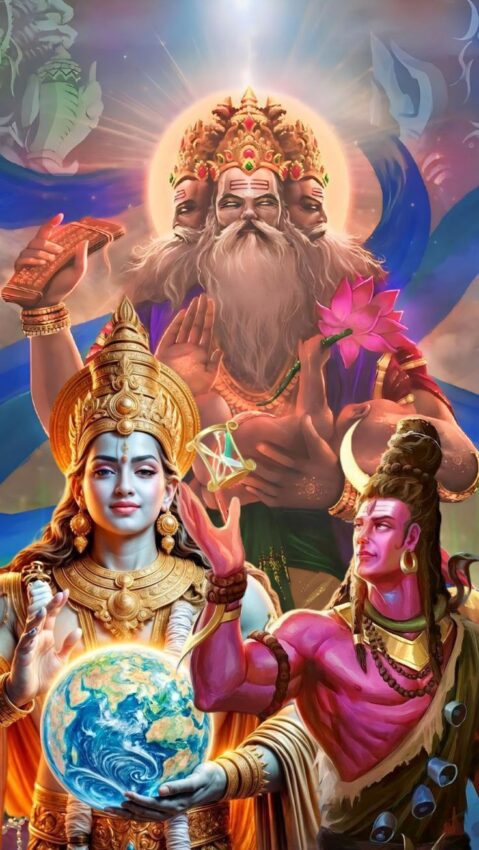Discover the roles of Brahma, Vishnu, and Mahesh in Hinduism. Learn about their importance in the creation, preservation, and destruction of the universe.

In Hinduism, there’s a powerful trio of gods known as the Trimurti. These gods are Brahma, Vishnu, and Mahesh (also known as Shiva). They are believed to control the universe’s entire cycle of creation, preservation, and destruction. Their roles are not just divine but essential to life itself. Each one of them shows a different aspect of the cosmic balance. Let’s take a closer look at these three gods and understand their significance.
1. Brahma – The Creator of Everything
Brahma is the creator god in Hinduism. Think of him as the architect of the universe. It’s said that he created the world, all living creatures, and even time itself. Brahma has four faces, each facing a different direction, symbolizing his ability to see everything at once. He holds a book, a rosary, and a water pot, representing knowledge, time, and the essence of life.
Brahma’s Role: Brahma is the creator. He is the one who brings everything into existence. From the stars to the Earth and every living being, Brahma made it all.
Why Brahma Isn’t Worshipped Much: Brahma plays a major role in creation. But, he is not as widely worshipped as Vishnu or Shiva. Some say it’s because, in Hindu mythology, Vishnu is believed to have given him this task. Brahma doesn’t have as many avatars (incarnations) as Vishnu or Shiva.
Did you know? Brahma’s consort is Saraswati, the goddess of wisdom and arts, who helps him create knowledge and beauty in the world.
2. Vishnu – The Protector and Preserver
Next, we have Vishnu, the god of preservation. While Brahma created the world, it’s Vishnu’s job to keep it in balance and protect it. Vishnu is often seen as a calm and loving figure. He is a divine protector. He ensures that evil never takes over the universe.
Vishnu’s Role: Vishnu preserves the world. He maintains peace, harmony, and justice. When things go wrong, Vishnu is the one who steps in to restore balance.
Symbols: Vishnu carries a conch. It calls people to righteousness. He also carries a discus, which destroys evil. Vishnu’s mace is a symbol of strength. A lotus flower symbolizes purity.
Vishnu’s Avatars: Vishnu is famous for his avatars (incarnations). The two most well-known are Rama and Krishna. These forms of Vishnu come to Earth to defeat demons and guide humans toward dharma (righteousness).
Fun Fact: Every time the world faces great destruction, Vishnu takes on a new avatar to restore balance. This includes famous avatars like the noble Rama. Another one is the playful Krishna.
3. Mahesh (Shiva) – The Destroyer Who Makes Way for New Life
Now, let’s talk about Shiva, or Mahesh—the god of destruction and transformation. While destruction might sound scary, in Hinduism, it’s essential. Shiva’s role is to break down the old, making room for something new. His destruction is actually an act of creation, a necessary process for renewal.
Shiva’s Role: Shiva is the destroyer. His destruction isn’t about killing. It’s about ending things to bring new life and growth. Without destruction, there can be no creation or preservation.
Symbols: Shiva carries a trident. It symbolizes the three gunas (qualities of nature). He has a crescent moon on his head, representing time. A snake is worn around his neck, symbolizing power and fearlessness.
Shiva’s Character: Shiva is both fierce and compassionate. He lives a simple life on Mount Kailash, often meditating in deep silence. But, when needed, he is a fierce warrior who destroys evil and protects his devotees.
Did you know? Shiva’s consort is Parvati, who is both nurturing and powerful. Together, they represent the balance between creation, preservation, and destruction.
Conclusion: The Cosmic Dance of the Trimurti
Brahma, Vishnu, and Shiva form the ultimate cosmic team. They work together to make sure the universe keeps turning—without one, the balance would be lost. Brahma creates, Vishnu preserves, and Shiva destroys to make way for new creation. Together, they keep the universe in constant motion, showing us the cyclical nature of life, death, and rebirth.
The Trimurti teaches us that change is constant. Everything that is born will one day end, but with every end comes a new beginning. Understanding Brahma, Vishnu, and Shiva helps us see the world in a deeper way. They show us how life flows.
For more insights into spiritual journeys, check out A Simple Guide to Shakti Peeths in India and Beyond. Alternatively, you can read about Lord Krishna’s Message of Love and Peace.
Stay connected with America112 for the latest updates and discussions on global matters.

